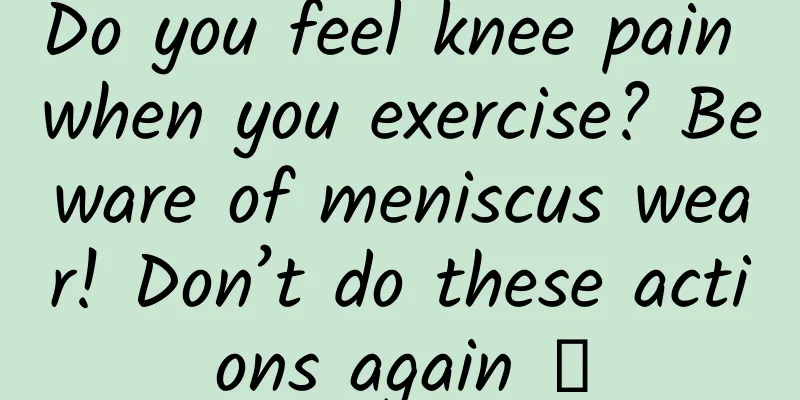Do you feel knee pain when you exercise? Beware of meniscus wear! Don’t do these actions again →

|
What is the meniscus? What is its function? What actions in daily life can damage the meniscus? How to prolong the life of the meniscus? Let's hear what the doctor says. What is the meniscus? What does it do? The meniscus is located inside the knee joint. It is an elastic fiber cartilage pad that has the functions of stabilizing, cushioning, and nourishing the joint. The meniscus can cushion the impact between the two bones, absorb shock, increase lubrication, and reduce friction, which helps the knee joint function normally. Once the meniscus is damaged, it is difficult to repair itself. Copyright images in the gallery. Reprinting and using them may lead to copyright disputes. What actions Will it cause damage to the meniscus? In sports such as football, basketball, badminton, skiing, taekwondo, and judo, some movements require flexion and twisting of the knee joint, which puts pressure on the meniscus and easily causes injury to the meniscus. In addition to these sports, in daily life, when people stand, walk, or go up and down stairs, the meniscus will be subjected to varying degrees of pressure. When standing, the knee joint force value is 100% When walking, the force on the knee joint is 200% When climbing stairs or going uphill, the force on the knee joint is 300% When going down stairs or downhill, the force on the knee joint is 400% When running, the force on the knee joint is 400% When playing ball, the force on the knee joint is 600% When squatting and kneeling, the force on the knee joint is 800% What are the symptoms Could this indicate meniscus damage? 1 swelling When the meniscus is acutely injured, bleeding and joint swelling may occur due to the rich blood supply in the joint. 2 pain Damage to any joint will cause pain, and when the meniscus is damaged, the pain is usually felt on both sides of the knee. 3 Snap When the knee joint is flexed and extended, it will make a "crunching" sound. If the sound is accompanied by pain, you must seek medical attention in time. 4 Interlock "Locking" means that the knee joint suddenly gets stuck, causing severe pain, inability to flex or extend normally, and inability to walk. This condition is mostly caused by a meniscus tear. How to treat meniscus damage? When the meniscus is acutely injured, the "PRICE principle" should be followed: "Protection" means appropriate protection. After an injury, do not continue to move despite the pain, but protect the joints appropriately. "Rest" means moderate rest. You can continue to move as long as the symptoms do not get worse. If the symptoms get worse, you should rest in time. "Ice" stands for ice compress. Applying ice compress around joints with a mixture of ice and water can suppress pain, reduce acute inflammatory exudation, and reduce swelling. "Compression" means applying pressure. When applying ice, you can use protective gear to apply pressure to reduce swelling, but the pressure should be appropriate. "Elevation" stands for raising the affected limb. Raising the affected limb above the heart allows blood to flow back and prevents swelling. Speaking of this, what are the treatments for meniscus injury? Doctors say that arthroscopic minimally invasive surgery is generally recommended after a meniscus injury. Doctors will trim or suture the meniscus according to the extent of the damage. If the meniscus is extremely worn and cannot be trimmed, the meniscus can be completely removed. Rehabilitation exercises will not affect the normal movement of the knee joint, but will accelerate the wear of the knee joint. How to extend the life of meniscus? If you feel discomfort in your knee joints, or have had a meniscus injury, it is recommended that you do not frequently perform exercises such as squats and mountain climbing in your daily life; warm up before exercise and avoid sudden stops and turns; manage your weight and increase muscle appropriately. In addition, experts recommend two movements to help you make your knee joints more flexible and extend the life of your meniscus. 1 Quadriceps stretch Stand with one leg straight. Bend the other leg and hold the instep with your hand. Keep the heel as close to the buttocks as possible to fully bend the knee joint and feel the quadriceps being stretched. Keep your legs close together and your spine in a neutral position. Alternate between the left and right legs, stretch the muscles on one side for 20 to 30 seconds, and do 2 to 3 sets a day. The elderly or people with poor balance can choose to practice lying on their side. Copyright images in the gallery. Reprinting and using them may lead to copyright disputes. 2 Lower body lunge Step one leg forward, bend the knee 90 degrees, and make the thigh parallel to the ground. Step the other leg back, with the toes on the ground. Keep your upper body upright. Alternate your legs and do 15 to 20 reps for each leg. Copyright images in the gallery. Reprinting and using them may lead to copyright disputes. Planning and production Source: People's Daily Online, CCTV-1, CCTV-1 "Population", "Healthy China" WeChat official account Editor: Cui Yinghao Some of the pictures in this article are from the copyright library Reprinting may lead to copyright disputes |
<<: How to promote children's growth? These exercises can help!
>>: Dental Implants: How Much Do You Know?
Recommend
How much does it cost to attract investment for the Longnan women’s clothing mini program?
How much does it cost to attract investment in th...
Why I still prefer Eclipse to IntelliJ IDEA
Over the years, I've seen a trend of moving f...
10 Mistakes Every Programmer Makes
[[131972]] The 10 mistakes listed in this article...
A mosquito bite left a bump on me. Will I get dengue or AIDS?
It is well known that the flying height and dista...
Yulin Mini Program Development Company, how much does it cost to develop a supplement mini program?
How much is the quotation for Yulin supplement de...
Why does cutting an onion make you cry? It's not because of the lyrics "peeling off my heart layer by layer"...
Onions are a vegetable that we often see in our d...
Will traditional car companies become assembly plants? Is the Foxconn model suitable for the automotive industry?
Foxconn does not design, market or sell a single ...
4 cool thoughts on live streaming sales
Since the beginning of 2018, the Internet industr...
How to promote enrollment in training institutions and educational training schools?
In recent years, the education and training indus...
Android solves ListView loading picture flickering
Recently, I was responsible for leading the compa...
A guide to private domain live streaming for education and training companies
2020 can be said to be the year of the live strea...
Sometimes, involution is also a waste of time | Scientific reverie
When paddling hard, don't forget to look up a...
【Game Promotion】See how the major game manufacturers do it! Marketing promotion strategy
Let’s take a look back at the last month of 2014....
If you think Chongqing is only spicy, then you don’t know it well enough
Text | Wei Shuihua Photo | Visual China When talk...
[Creative Cultivation Program] The mystery of the origin of mitochondria: How was the energy factory of eukaryotic cells built?
Regarding the origin of mitochondria, scientists ...









